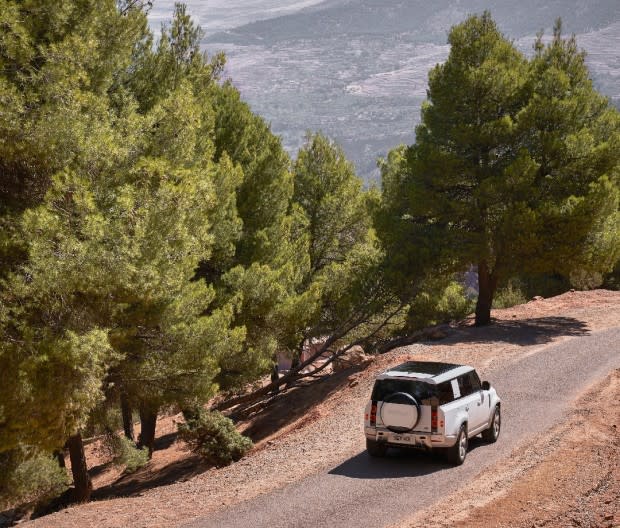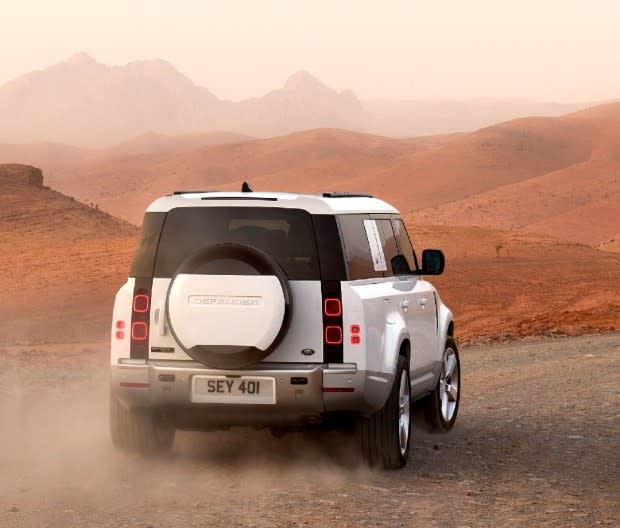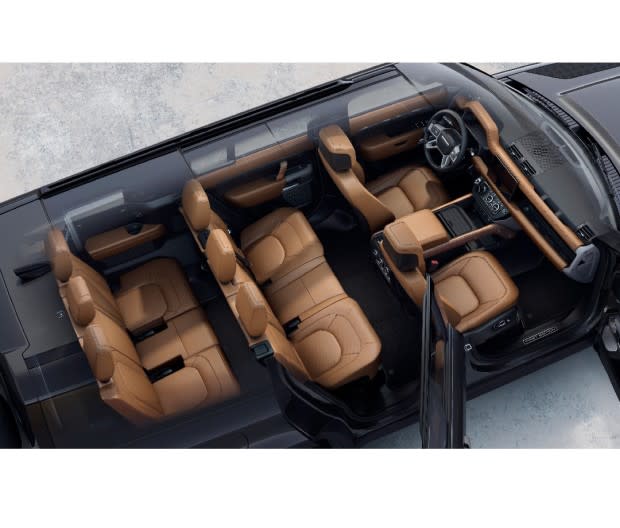First Drive: 2023 Land Rover Defender 130 Proves Three Rows Can Be Exciting
Let’s clear this up right away. The Land Rover Defender 130 is an epic exception to the three-row SUV rule. Those large, lumbering hulks lurching around the suburbs are mostly just minivans in all-wheel-drive disguise, making for the totally joyless driving experience you expect. Cut a couple inches from the ride height, replace a rear door with a sliding one, and you’re back in your parent’s Previa, Aerostar, or Caravan. For the most part, three-row vehicles are a compromise made “necessary” by certain life choices (aka children). I own one and speak from 50,000 miles of experience. They suck. Big SUVs—not kids.
The Land Rover Defender 130, on the other hand, is not your dad’s Chevy Astro van. Sure, it will haul your kids, their friends, the dogs, and a coach’s bag of soccer balls—but the Defender can trace its lineage back to some of the most iconic off-roaders ever built. In its current form, it both looks and feels unlike anything else on the road today.

Courtesy image
Gitty Up and Go
For the moment, the 2023 Defender 130 comes win two mild hybrid 3.0 liter turbocharged in-line six-cylinder powertrains. The P300 version gives the throttle command of 296 hp and 347 lb-ft of torque, while the P400 commands 395 hp/406 lb-ft. The pair gets from 0 to 60 mph in 7.5 and 6.3 seconds, respectively. Both come mated to an eight-speed, ZF automatic transmission and an electrically driven supercharger to mitigate turbo lag.
The 2024 model year offers the option of a V8 with 493 hp and 450 lb-ft of torque and snap off to 60 almost a second faster (5.4 seconds.)

Courtesy image
Behind the Wheel
There are no bells and whistles that would make the Defender 130 feel less gargantuan. It’s a big, boxy bus. But that's the point. Land Rover added more than a full foot over the four-door 110 version (13.4 inches,) all of it behind the rear wheels for the sake of the back row passengers.
Adding length equals more metal and more weight. The 130 is beefed up roughly 600 lbs compared to the 110—to a total curb weight of 5,600 lbs.
Related: Chevrolet Colorado ZR2 Pickup Is a Desert Monster
That said, it’s rather satisfying in its own way. The size, height, and build quality make it feel nearly indestructible. You get the sense that it’s sort of a rolling Chuck Norris joke. The Defender doesn’t dodge potholes. Potholes duck at the sight of the Defender.
Hyperbole aside, all but the most massive bumps you hit in the Defender get smoothed out by the standard air suspension and adaptive dynamics. The steering feels sharp and offers plenty of feedback for an off-road specialist—but with all that girth, you don’t want to come into corners super hot. The brakes don’t grab quite as aggressively as they do in the 110, so better to get on them a bit early and manage it through the bends.

Courtesy image
The P400 I tested generally offered plenty of power, though it was a bit sluggish when winding up on the highway. The V8 in the smaller Defender 110 I drove last summer felt much more capable and appropriate for a road-going schooner. Of course, it’s a bit pricier. The V8 model costs nearly 50 percent more than the sticker of the well-equipped P400 SE I drove. Land Rover hasn’t released fuel economy estimates for the V8, but it’s certainly thirstier than P400’s unleaded-chugging V6 that manages a mere 17 mpg city and 21 mpg highway (19 mpg combined.)
While all of the Defender’s powertrains are rated to tow up to 8200 lbs, if you’re frequently hauling a small boat or trailer around, the V8 might be worth the upgrade.
Just like the other variants, the 130 comes with a full-sized spare tire hitched to its side-hinged tailgate, which blocks a good bit of rear visibility. But with a flip of a switch the rearview mirror displays the camera view from the back, so you don’t have to worry about what you can’t see when you’re backing out of the driveway.
After a week behind the wheel, my only substantial gripe comes on the highway. At speeds over 60 mph, the air seems to scream off the big, honking side mirrors. Thankfully, the test model came outfitted with the 700-watt Meridian sound system to drown out wind noise.

Courtesy image
On the Inside
It’s sort of an odd straddle, but Defender manages to feel both utilitarian and luxurious at the same time. Rather than burled wood or carbon fiber, the trim is mainly durable plastic accented with visible bolts and rivets. It’s a treatment that cleverly contrasts the well-padded, supple leather seating and accents.
Related: GM's Hummer EV Is Its Most Monstrous Electric Flex Yet
The massive center console, door nooks, and dashboard cubby all ensure tons of storage for passenger phones, drinks, or other gear, while the PiviPro infotainment system seamlessly manages Defender’s nav and settings. For those who would prefer their phone to drive the music or maps, Defender also offers Apple CarPlay and Android Auto.

Courtesy image
With all three rows up and ready to ride, the cargo area is only big enough to accommodate a pair of carry-ons, but with all the rear seats stowed, there’s 81 cubic feet of cargo space. Not bad, but weirdly the Land Rover’s storage floor isn't flat. The third row juts up a bit creating a sort of a plateau, which can make it tough to slide your gear into the back.

Courtesy image
The Way Back
Getting into the third row, as in most vehicles of this ilk, requires a bit of flexibility. But once ensconced, it’s not a terrible place to sit even for a six-foot-tall human. I managed to slink into the back without hurting myself (impressive, I know) and was pleasantly surprised with the experience. There’s ample space overhead as well as an extra moonroof that gives the third row an airy quality. The leg room was acceptable—plenty for an hour-long ride, though I wouldn’t want to be stuck there much longer. There are even USB-C chargers to keep the iPads gassed up and the kids quiet.

Courtesy image
Hit the Trails
If you, unlike most of the folks who will buy one, do have the inkling to head off-road, the 130 lives up to the Defender legacy. When it’s time to hit the dirt, ground clearance can be increased from the normal 8.5-inch to 11.4 inches and the Defender can ford nearly three feet (35.4 inches) of water—in case you find yourself on the wrong side of a Hudson River tributary or an incredibly soggy steeplechase.
The 38-degree approach angle is the same as the others in the Defender line, but due to the increase in length in the rear, the departure angle is diminished from the Defender 110's 40.0 degrees to 28.5 degrees for the 130.

Courtesy image
The standard all-wheel-drive system includes a two-speed transfer case with a locking front differential. For those who need one, a locking rear diff comes as an optional extra. Off-roading enthusiasts should also consider swapping out the Pirelli Scorpion all-season tires for some rubber better suited for mud and rocks.
Three rows and Land Rover heritage is a compelling argument for the Defender. It’s a real off-roader, and not just a minivan doing a bit of cosplay. Of course, few who decide to put one in the garage will dare to take their adventures off the tarmac. But luxury isn’t all leather and hand finished wood. It’s also knowing that if you want to, you can.
[From $69,100; landroverusa.com]

Solve the daily Crossword

